Dental Dam Market Size and Trends
The dental dam market is estimated to be valued at USD 161.5 Mn in 2025 and is expected to reach USD 271.6 Mn by 2032, growing at a compound annual growth rate (CAGR) of 7.7% from 2025 to 2032.
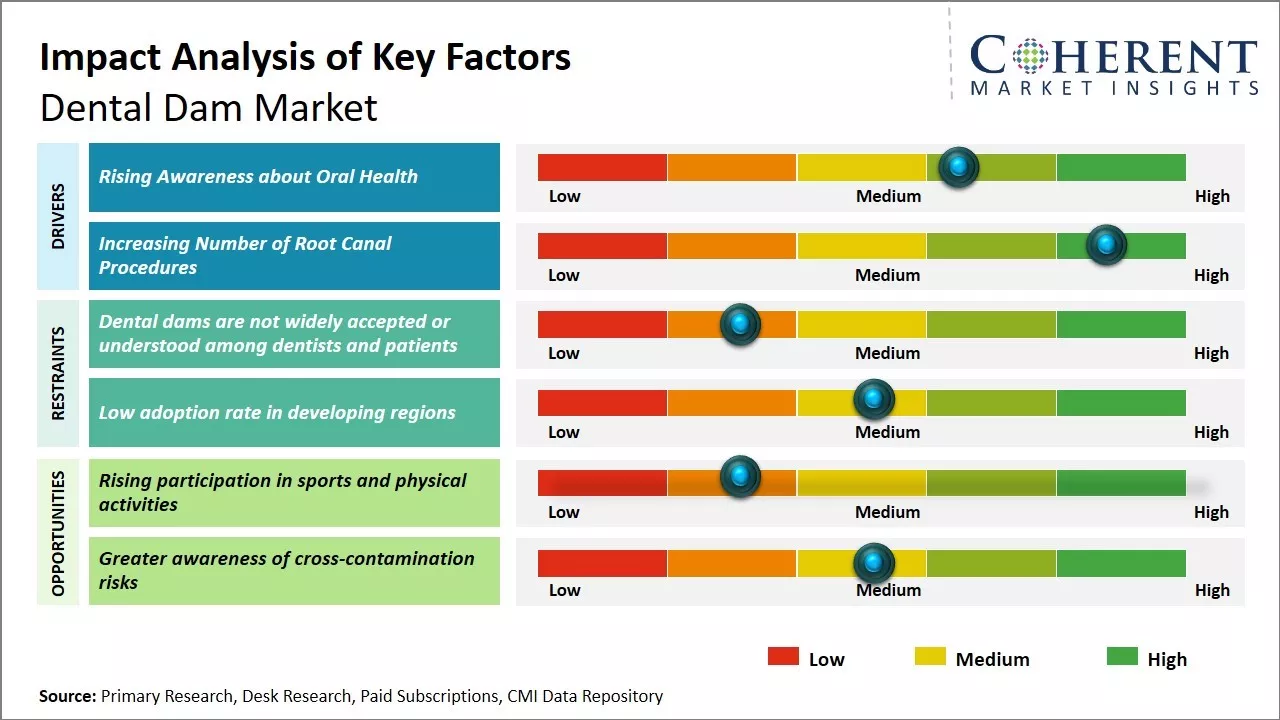
Discover market dynamics shaping the industry: Download Free Sample
The market is expected to witness positive growth over the forecast period. Rising awareness regarding oral hygiene and increasing the prevalence of dental diseases are some key factors driving the growth of the dental dam market. Additionally, advancement in dental materials used for manufacturing dental dams along with the growing demand for minimally invasive procedures are further expected to support the revenue generation in the dental dam market. Wide acceptance of dental procedures and growing number of dental surgeries will also contribute to the market growth. However, the availability of alternative products for isolation may impede the market expansion to some extent over the coming years.
Rising Awareness about Oral Health
With growing awareness about the importance of oral hygiene and regular dental check-ups, the demand for products that ensure good oral health is increasing. Dental dams are gaining popularity as they provide an effective barrier during various dental procedures and treatments to prevent cross-contamination. They help block fluids, bacteria, and dental instruments from entering the mouth and affecting other areas. This is crucial for procedures like root canal where the tooth cavity is exposed. Dental professionals are educating people about the various steps needed to maintain oral health. They emphasize the need for isolating one part of the mouth from others during treatments to avoid infection. As people pay more attention to dental health, the importance of using dams is rising. Various oral health campaigns by dental associations and governments have brought these single-use barriers into mainstream focus.
Market Concentration and Competitive Landscape
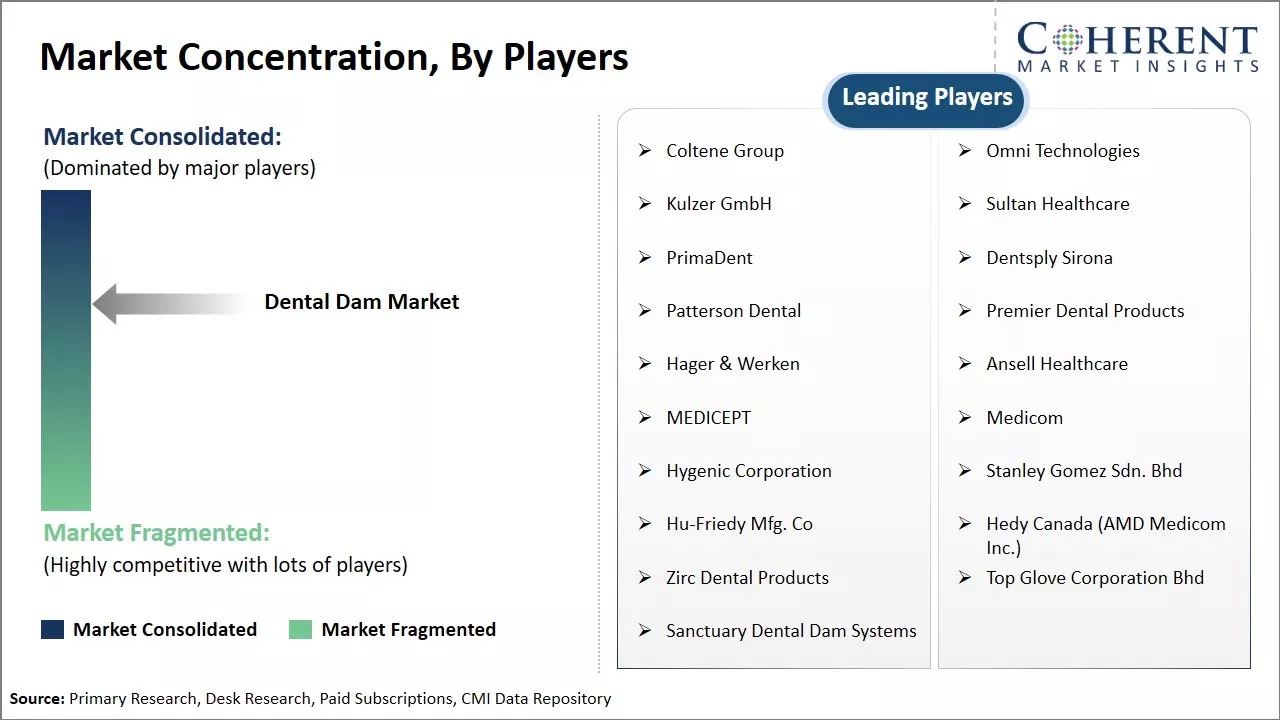
Get actionable strategies to beat competition: Download Free Sample
Increasing Number of Root Canal Procedures
There is a steady rise in the number of root canal procedures performed globally each year. This complex treatment involves removing the inflamed or infected pulp from the inner chambers of the tooth and then filling and sealing the inside. During such an invasive process where instruments are moving in and out of the exposed tooth cavity, cross-contamination is a risk. To prevent bacteria transfer to other areas, professionals use dental dams as a physical barrier. Their role is crucial in isolating the treatment site. As root canal cases increase, especially with a growing geriatric population more prone to dental issues, so does the need for dams. They serve as an essential infection control measure adopted in all root canal treatments. Even minor dental procedures such as fillings often involve using dams to separate one part of the mouth from others. This dependency on single-use barriers is driving greater demand.
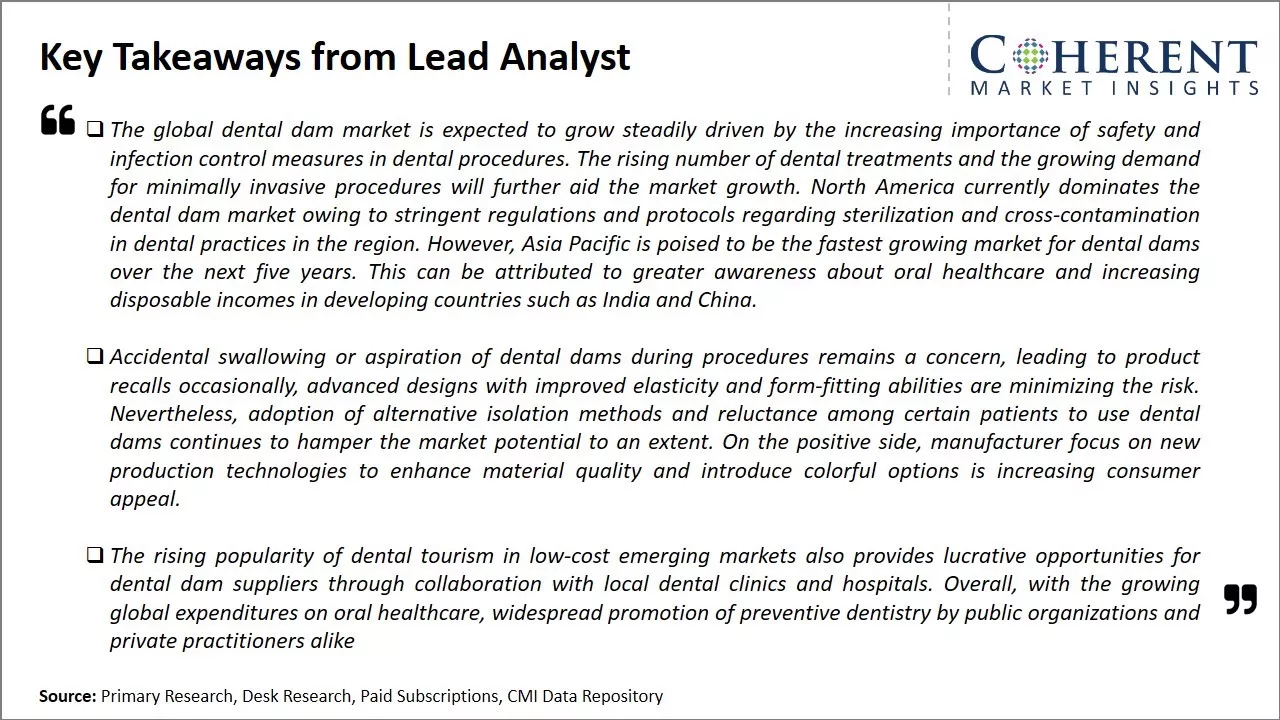
To learn more about this report, Download Free Sample
Market Challenges: Dental dams are not widely accepted or understood among dentists and patients
The global dental dam market faces several challenges. Dental dams are not widely accepted or understood among dentists and patients. Many view them as unnecessary for common procedures like fillings. Additionally, dental dams can be difficult to place correctly. This improper use potentially reduces their effectiveness. Younger generations especially may find dental dams outdated or unappealing compared to modern alternatives. Manufacturers must overcome cultural hesitancy and perceptions that dental dams are only for specific needs like oral surgery.
Market Opportunities: Greater awareness of cross-contamination risks
Greater awareness of cross-contamination risks could boost adoption rates. As baby boomers age, demand may increase for procedures dental dams facilitate, like root canals. Recent innovation has improved dental dams' size, shape, and application to address past issues. Increased attention on prevention offers chances to highlight dams' role in maintaining oral health.
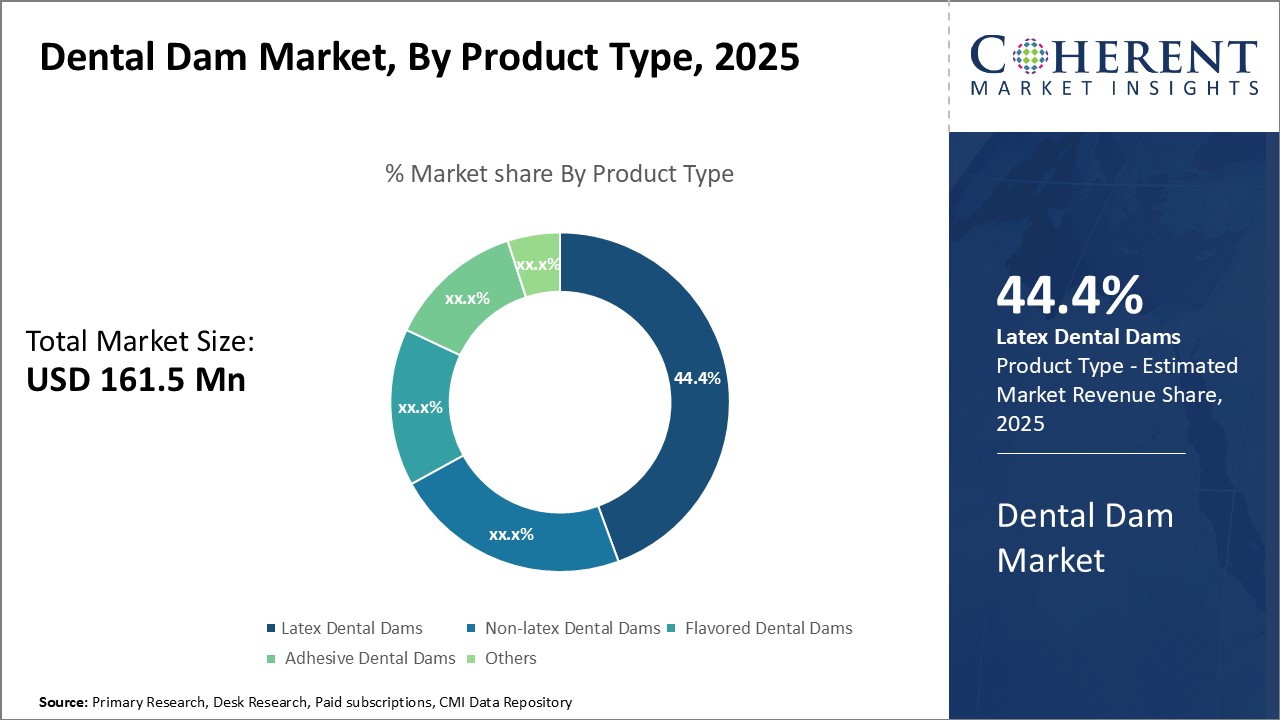
Discover high revenue pocket segments and roadmap to it: Download Free Sample
Insights, By Product Type: Superior Properties Drive Latex Dental Dams Demand
In terms of product type, latex dental dams contributes 44.4% share of the market owing to its superior properties compared to other materials. Being derived from natural rubber latex, latex dental dams offer an optimal combination of strength, flexibility, and durability required for various dental procedures. Their elastic and durable nature allows them to be easily stretched and firmly placed on the treatment area. Latex also acts as an effective barrier against moisture and airborne particles, thus protecting both the patient and dentist from cross-contamination during procedures. Additionally, latex dental dams tend to be thinner yet stronger compared to other substitutes like non-latex variants. This aids in increased visibility and maneuverability for dentists during complex restorative or surgical treatments. The biocompatible nature of latex further makes it well-suited for procedures involving direct contact with oral soft tissues or wounds. Its elastic properties also help maintain an effective seal throughout the procedure duration. Collectively, these superior handling advantages and protection benefits have established latex as the top choice for both professionals and patients.
Insights, By Application Type: critical role dental dams play in maintaining oral cleanliness
In terms of application type, patient hygiene contributes 44.9% share of the market owing to the critical role dental dams play in maintaining oral cleanliness and preventing infections. Proper hygiene practices are indispensable for oral healthcare, and dental dams facilitate this by acting as a barrier during various cleaning or examination procedures. They help isolate the treatment area, control contaminants and prevent saliva overflow. This isolation allows for better visibility and access for dentists to thoroughly inspect the oral cavity, interdental spaces and gumlines for any issues. Dental dams also enable efficient and focused cleaning of individual teeth and interproximal surfaces using floss or irrigators. Additionally, their use prevents saliva-soaked cotton rolls or gauze pieces from falling back into the mouth during suction or drying. This avoids unnecessary aspirations, aiding comfort. With rising awareness on oral hygiene, the demand for dams from both dentists and patients is growing steadily to achieve comprehensive cleanings essential for oral and systemic wellness.
Insights, By Sales Channel: Expanding Access Drives Online Channels’ Popularity
In terms of sales channel, the online segment contributes 42.7% of the market share owing to expanding access and robust growth of e-commerce. While offline channels like pharmacies and clinics have traditionally been the main procurement sources, online platforms are fast gaining popularity amongst both consumers and dentists. This can be attributed to their seamless and flexible shopping experience along with competitive pricing. Sites offer a wide assortment of dams from various brands in different packaging and latex variations. They also provide delivery to remote locations facing limited product availability locally. Reviews and comparisons further help buyers select the most suitable options based on individual practice needs or budgets. Moreover, bulk or subscription purchase opportunities on such channels give additional cost savings. The covert nature of online ordering also encourages those apprehensive about purchasing dams in person. With growing internet and smartphone penetration globally, online channels are poised to dominate the dental dam sales landscape in the coming years through their unique accessibility and convenience factors.
Regional Insights
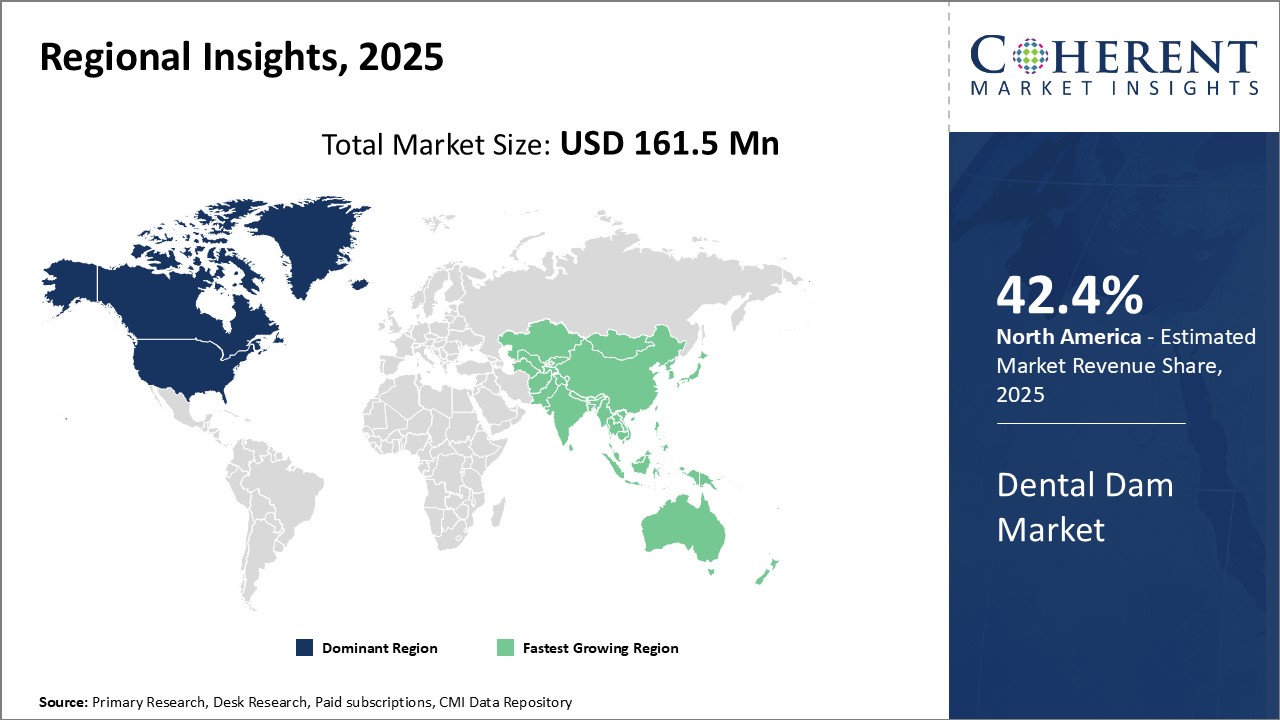
Need a Different Region or Segment? Download Free Sample
North America continues to hold 42.4% share in the global dental dam market. The region has a strong presence of key manufacturers who have established their brand presence over the years. Countries like the U.S. and Canada have a well-developed healthcare infrastructure and high patient awareness levels regarding dental procedures. Many dental colleges and programs in the region promote the use of dental dams for root canal treatments and other procedures. This has ensured steady demand from dental practitioners. Additionally, the reimbursement structure for various dental treatments involving dental dams is favorable in the region. This compensates dentists well and boosts their preference for advanced protection equipment like dental dams.
The Asia Pacific region has been witnessing highest growth and is emerging as one of the fastest growing markets for dental dams. Rapid economic development and improving access to healthcare has been crucial factors. Countries like China, India, and South Korea are witnessing rising disposable incomes and growing dental tourism industries. International as well as local players have identified tremendous market potential in these countries and have increased their focus on Asia Pacific. They are tapping opportunities through partnerships with major dental supply dealers and distributors. Rising oral healthcare spending and growing number of dental practitioners are benefitting the market. The demand from value-conscious consumers is also meeting through private label offerings from local producers at competitive rates. This is positively impacting the market expansion.
Market Report Scope
Dental Dam Market Report Coverage
| Report Coverage | Details | ||
|---|---|---|---|
| Base Year: | 2024 | Market Size in 2025: | USD 161.5 Mn |
| Historical Data for: | 2020 To 2024 | Forecast Period: | 2025 To 2032 |
| Forecast Period 2025 to 2032 CAGR: | 7.7% | 2032 Value Projection: | USD 271.6 Mn |
| Geographies covered: |
|
||
| Segments covered: |
|
||
| Companies covered: |
Coltene Group, Omni Technologies, Kulzer GmbH, Sultan Healthcare, PrimaDent, Dentsply Sirona, Patterson Dental, Premier Dental Products, Hager & Werken, Ansell Healthcare, MEDICEPT, Medicom, Hygenic Corporation, Stanley Gomez Sdn. Bhd, Hu-Friedy Mfg. Co, Hedy Canada (AMD Medicom Inc.), Zirc Dental Products, Top Glove Corporation Bhd, and Sanctuary Dental Dam Systems |
||
| Growth Drivers: |
|
||
| Restraints & Challenges: |
|
||
Uncover macros and micros vetted on 75+ parameters: Get instant access to report
Market Segmentation
- Product Type Insights (Revenue, USD Mn, 2020 - 2032)
- Latex Dental Dams
- Non-latex Dental Dams
- Flavored Dental Dams
- Adhesive Dental Dams
- Others
- Application Type Insights (Revenue, USD Mn, 2020 - 2032)
- Patient Hygiene
- Surgery
- Restorative Treatment
- Respiratory Disease Treatment
- Others (Cosmetic Use)
- Sales Channel Insights (Revenue, USD Mn, 2020 - 2032)
- Online
- Offline
- Regional Insights (Revenue, USD Mn, 2020 - 2032)
- North America
- U.S.
- Canada
- Latin America
- Brazil
- Argentina
- Mexico
- Rest of Latin America
- Europe
- Germany
- U.K.
- Spain
- France
- Italy
- Russia
- Rest of Europe
- Asia Pacific
- China
- India
- Japan
- Australia
- South Korea
- ASEAN
- Rest of Asia Pacific
- Middle East & Africa
- GCC Countries
- Israel
- Rest of Middle East & Africa
- North America
- Key Players Insights
- Coltene Group
- Omni Technologies
- Kulzer GmbH
- Sultan Healthcare
- PrimaDent
- Dentsply Sirona
- Patterson Dental
- Premier Dental Products
- Hager & Werken
- Ansell Healthcare
- MEDICEPT
- Medicom
- Hygenic Corporation
- Stanley Gomez Sdn. Bhd
- Hu-Friedy Mfg. Co
- Hedy Canada (AMD Medicom Inc.)
- Zirc Dental Products
- Top Glove Corporation Bhd
- Sanctuary Dental Dam Systems
Share
Share
About Author
Komal Dighe is a Management Consultant with over 8 years of experience in market research and consulting. She excels in managing and delivering high-quality insights and solutions in Health-tech Consulting reports. Her expertise encompasses conducting both primary and secondary research, effectively addressing client requirements, and excelling in market estimation and forecast. Her comprehensive approach ensures that clients receive thorough and accurate analyses, enabling them to make informed decisions and capitalize on market opportunities.
Missing comfort of reading report in your local language? Find your preferred language :
Transform your Strategy with Exclusive Trending Reports :
Frequently Asked Questions
EXISTING CLIENTELE
Joining thousands of companies around the world committed to making the Excellent Business Solutions.
View All Our Clients
